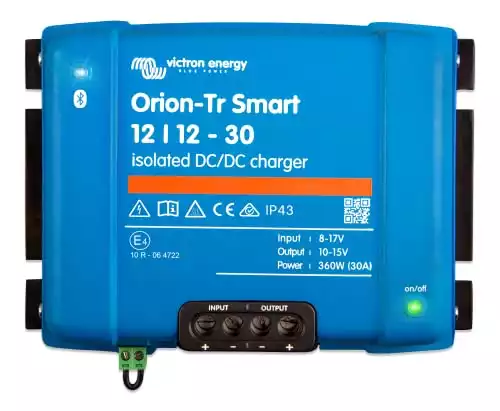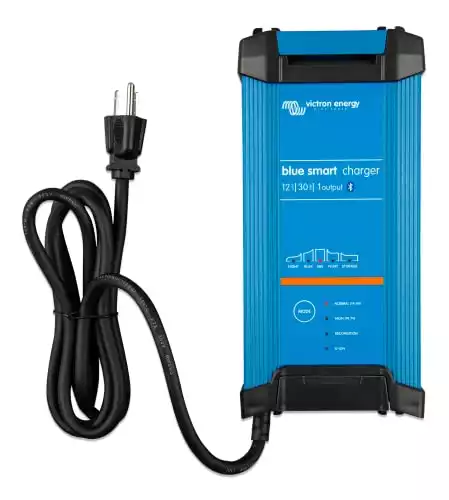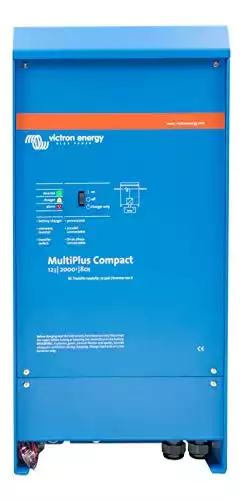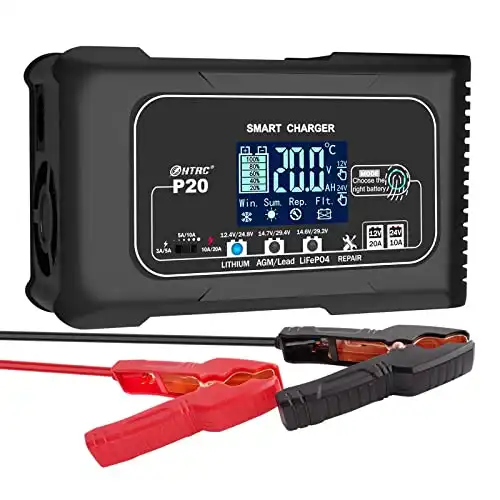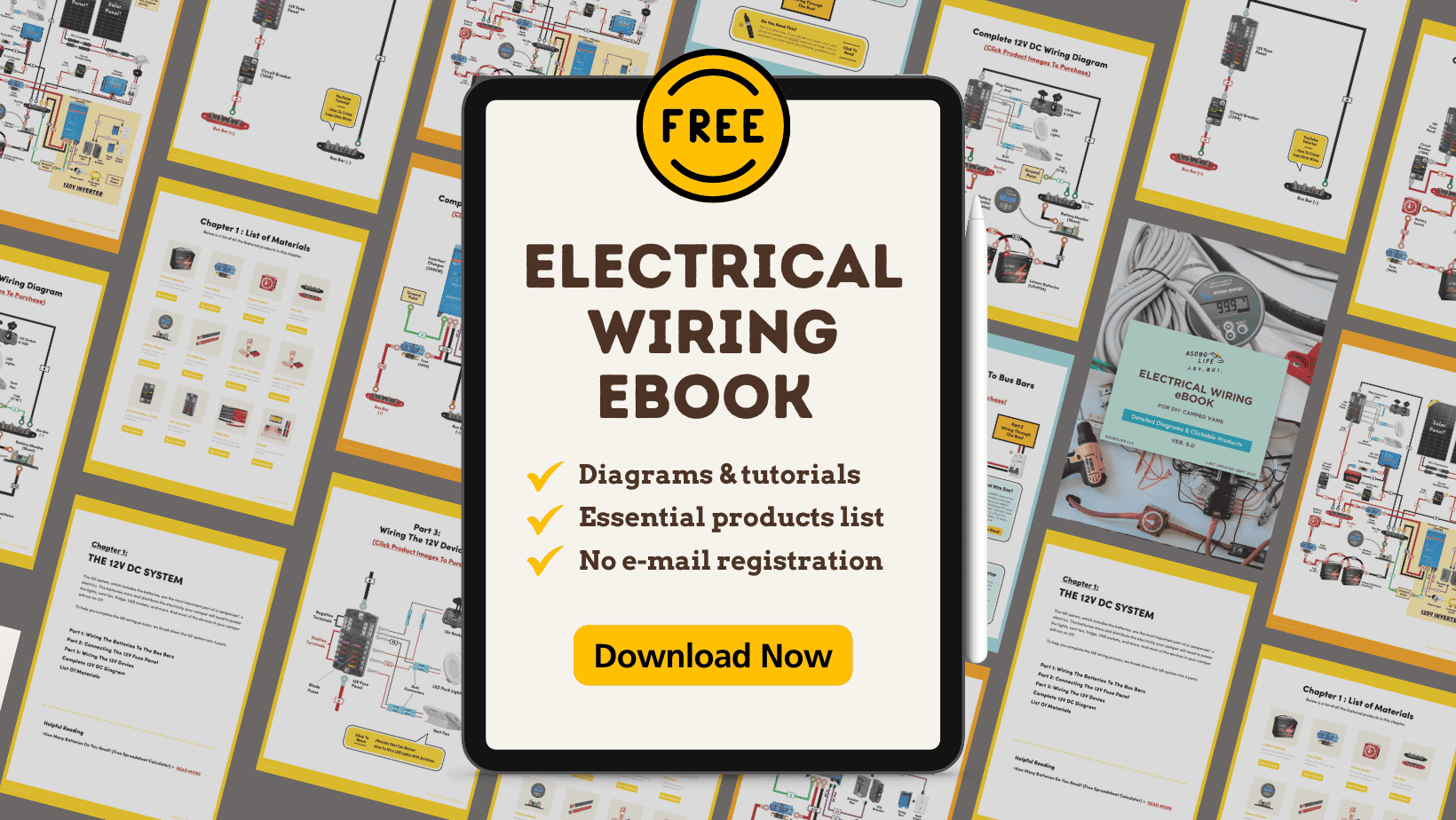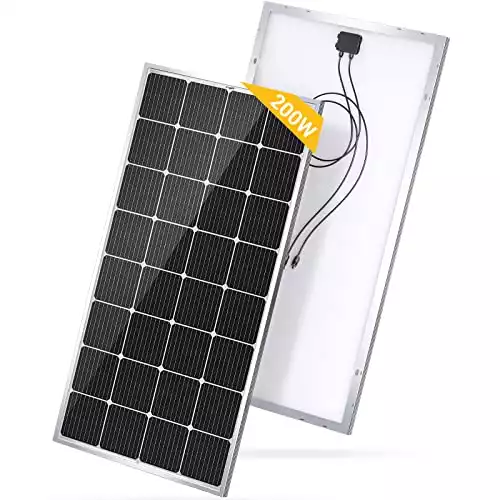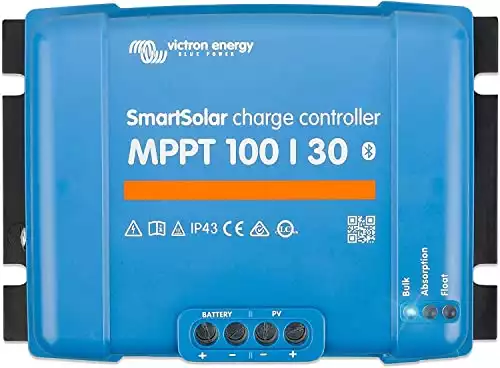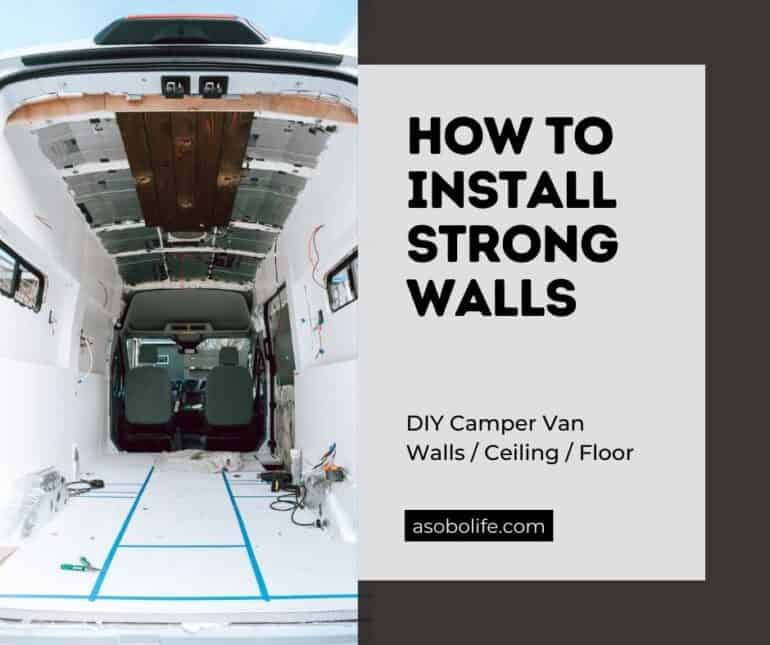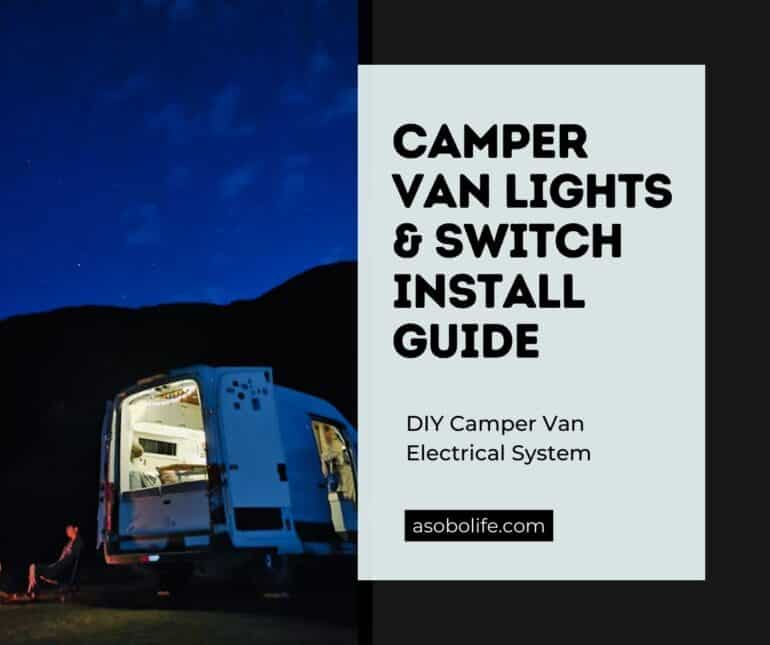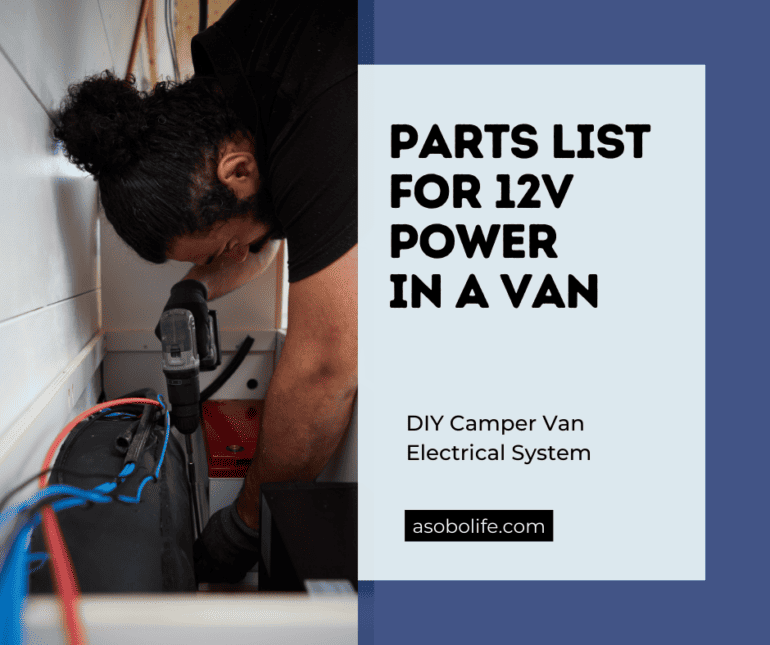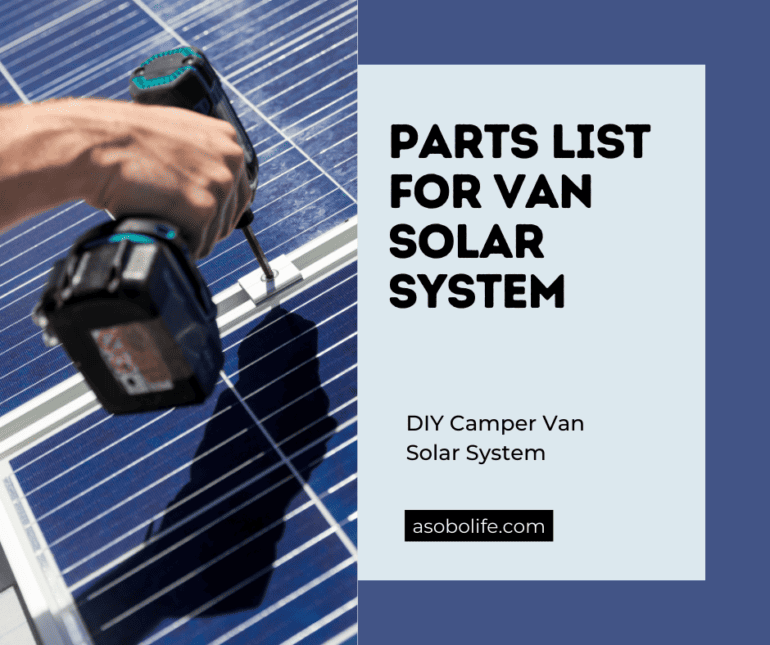4 Ways To Charge a Camper Van Leisure Battery
A camper van leisure battery is necessary to power all the electrical devices in your van. But without a way to recharge your battery, these electrical devices will eventually drain the battery completely. An empty battery means no more power. That is why learning how to charge your camper van leisure battery is critical.
Here are the four common ways to charge a camper battery:
- Solar panels
- DC-DC charger (from vehicle alternator)
- Shore power
- Generator (gas/propane)
In this post, we review each standard charging solution, review their pros & cons, and give our best product recommendations. At the end of the post, we discuss which of the four charging solutions we use in our camper van and how much we rely on each solution to power our batteries.
Don’t Know Anything About Camper Van Batteries? Read our leisure battery guide to get a basic understanding of camper batteries. This will help you before reading this comparison post.
So, if you’re ready, let’s dive into it.

Disclosure: As an Amazon Associate, this site earns from qualifying purchases. Though we may earn a commission, the price you pay always remains the same.
1. Charge With Solar Panels
Utilizing solar panels is a popular way camper vans charge their leisure batteries. Solar panels convert sunlight into direct current (DC) electricity, which is then stored in the batteries through a charge controller. Because of their renewable, eco-friendly solution, van lifers increasingly turn to solar power as their primary charging solution.
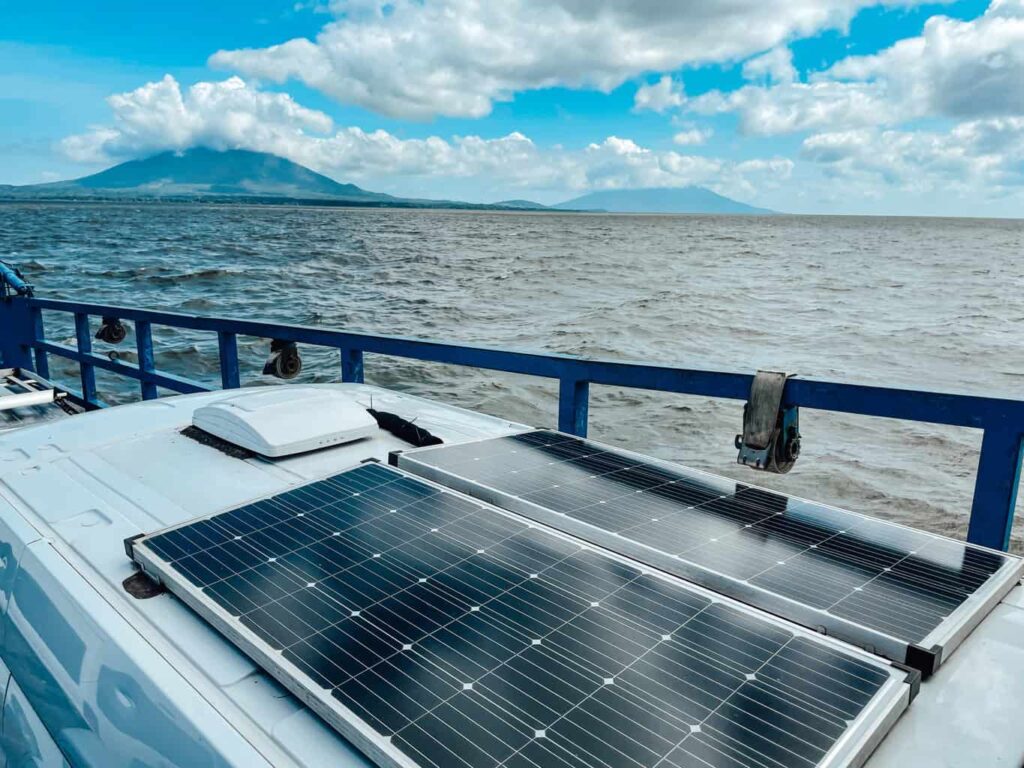
Based on our experience with solar panels, we discuss the pros and cons below. We’ll go into more specifics on each point after the table.
Pros of Solar Panels
Clean Energy Source
Power is made from sunlight only. Unlike when connecting to the traditional power grid, solar panels do not charge the batteries using natural gas, coal, or nuclear power.
Passive Charging
As long as the solar panels receive sunlight, they will send power to the batteries. It is a passive process that involves no additional work on your part. You can be wild camping miles away from civilization, and your batteries can still receive power from solar panels.
Energy Independence
Relying on solar panels for power means you won’t depend on traditional RV parks to provide power for your camper van. This is important if you enjoy wild camping and staying away from paid campgrounds.
Improves Resale Value
If you think you might sell your camper van, installing solar panels will command a higher selling price and help you recoup some of your solar expenses.
Cons of Solar Panels
Not Cheap
Not only will you need to spend money on solar panels themselves, but you will also need to purchase a solar charge controller, fuses/breakers, connectors, and wires.
Tricky To Install
There are calculations you must do to size your solar system correctly. Afterward, you must buy several products and components and piece everything together. It’s not rocket science, but it can be tricky if you are installing solar panels for the first time. Download our free solar PDF with helpful wiring diagrams to get you started.
Sunlight Dependent
Unsurprisingly, solar panels are dependent on sunlight to function. If your camper van is parked in the shade or if it is an overcast day, the solar panels won’t be able to produce sufficient power to power your leisure batteries.
How Long To Charge Batteries From Solar Panels?
The amount of time it takes to replenish your batteries from solar depends on the size of your battery bank, how many watts of solar you have, and how much sunlight there is in the day. There are a lot of factors to take into account, so there is no solid answer.
Our blog can help you calculate the adequate amount of battery and solar you will need for van life in two steps.
1. Battery Size Calculator
The battery size you need depends on how much power you require to operate all the electrical devices in your van. Visit our battery calculator post to help you determine your ideal battery size.
2. Solar Size Calculator
Once you have determined your battery size, our solar calculator helps you calculate the amount of solar watts you need to keep your batteries sufficiently charged daily.
We have used this calculation method for our camper van build, and it has served us exceptionally well even during the rainy seasons, winter months, and when parked in shaded campsites. However, relying solely on solar power to charge your leisure batteries is not the best idea. Instead, we recommend pairing your solar panels with additional charging solutions.
Once you’ve picked out your solar panels and are ready to install them, check out our camper van solar install guide to help you get started. We also provide a solar wiring eBook, which includes valuable wiring diagrams and product recommendations. It’s free to download.
2. Charge While Driving (DC-DC Charger)
Camper van batteries can also be charged by receiving power from the vehicle’s alternator. An alternator is a device that connects to the van’s engine and generates electrical power when the motor is on. The purpose of the alternator is to charge the vehicle’s starting battery when driving.
By connecting the leisure batteries to the starting battery, which is already connected to the alternator, the leisure batteries can also receive a charge when the engine is running. To do this, you must install a split charge relay or DC-DC charger (preferred) between the leisure and starter batteries.
- Split Charge Relay (Battery Isolator) – Cheap, but only with lead-acid batteries.
- DC-DC Charger – More intelligent device. Works with lithium batteries.
Since we firmly believe you should be using lithium batteries for your van conversion, we recommend the Victron Orion DC-DC charger for anyone interested in charging their leisure batteries while they drive. We use this charger and love the device’s functionality, high-quality build, and Bluetooth capability.
Charge your leisure batteries quickly with Victron's 30A DC-DC charger (up to 360W). Works great for both lithium and AGM batteries. But the highlight is the charger's Bluetooth connectivity, which pairs with Victron's UX-friendly smartphone app.
Based on our experience with our charger, we would list the pros and cons of DC-DC charging as follows.
When you’re ready to install, read our DC-DC charger installation guide. The post includes helpful product lists and wiring diagrams.
3. Charge From Shore Power With A Battery Charger
The term ‘shore power’ is defined as any electrical socket outside a camper van connected to the power grid. A shore power socket could be located at a campsite, in your garage, or even at a gas station.
However, because shore power is supplied in alternating current (AC) power and the batteries operate on direct current (DC) power, you will need the appropriate charging equipment to utilize shore power sockets to charge your batteries. The two most popular chargers are:
Most camper vans use battery chargers to charge their batteries from shore power. Inverters typically convert DC power from the batteries to AC power. However, if you get an inverter with an additional charger module, you can also convert AC power back to DC power to charge the batteries.
- Inverter/Charger Combo Units – These are typically larger devices that convert 12V to 120V (and vice versa). They also tend to be more expensive than standard inverters.
- Standalone Chargers – Only convert 120V to 12V, but are considerably smaller and cheaper than inverter/charger combos.
Below is an example of a Victron standalone charger and an inverter/charger combo. We love the 2000W inverter/charger, but it is more expensive than just the charger itself.
|
Simple dedicated battery charger to recharge batteries from shore power. |
Powerful 2000W inverter/charger combo unit. We use this unit in our camper van. |
Simple dedicated battery charger to recharge batteries from shore power.
Powerful 2000W inverter/charger combo unit. We use this unit in our camper van.
Based on our experience with shore power charging, we would list the pros and cons of shore power charging as follows.
Check out our inverter/charger installation guide when you’re ready to install, which includes helpful product lists and wiring diagrams.
Budget Alternative: If the Victron models are out of your budget, consider a simple 20A battery charger. The recommended charger below is compatible with both AGM and lithium batteries.
A convenient, low-cost, and space-efficient battery charger that works with lithium & lead-acid (AGM) auxiliary batteries.
4. Charge From A Generator
Connecting to a portable generator is another way to charge a camper van battery. Most generators require either gasoline or propane (LPG) to run. Generators are convenient because you don’t need to rely on sunlight or drive a certain distance to function. As long as you have gas or propane, the generator will provide ample power to send a charge.
However, portable generators are not popular within the camper van community because they can be loud when turned on. We wouldn’t want to be wild camping in a pristine, quiet setting only to have the moment ruined by a noisy generator humming in the background. Some campgrounds do not allow the use of generators because of their noise. If they aren’t prohibited, we doubt your neighbors would enjoy hearing your generator churning out power.
But generators can be helpful in emergencies. So, for some, carrying a small portable generator, like the recommendation below, can help provide power as a last resort.
How We Charge The Leisure Batteries In Our Camper Van
Having sufficient power to run our electronics is critical. Because we work remotely, we value power reliability and cannot afford our batteries to run out of charge. That is why we set up our van’s electric system to charge our leisure batteries in three ways.
1. Solar Panels (360 Watts)
We have two 180W solar panels on our van’s roof and direct the power through our Victron charge controller to the leisure batteries. On a long and sunny day, we can put as much as 1.8kWh back into our batteries. On average, our solar panels provide roughly 60% of the total power used to charge our batteries.
2. Victron DC-DC Charger (30 Amps)
The second way we charge our batteries is by connecting the batteries to the van’s alternator through a DC-DC charger. We opted for the DC charger instead of the cheaper split charge relay because our lithium (LiFePO4) leisure batteries are a different chemistry than our AGM starter battery. If you have lithium batteries, use a DC-DC charger instead of a split charge relay.
The DC-DC charger works excellently when the solar panels are in the shade and cannot supply sufficient power to our batteries. But with the DC charger, our batteries can still be charged back to full after just a few hours of driving. On average, the DC charger provides roughly 25% of the total power we put in to our batteries.
Charge your leisure batteries quickly with Victron's 30A DC-DC charger (up to 360W). Works great for both lithium and AGM batteries. But the highlight is the charger's Bluetooth connectivity, which pairs with Victron's UX-friendly smartphone app.
3. Victron Inverter/Charger (2000 Watts)
The third way we charge our leisure batteries is by connecting to shore power with our inverter/charger. When plugged in, our Victron inverter can put ~750Wh of power back into our batteries each hour. However, because our solar panels and DC-DC charger already do an excellent job keeping our batteries charged, shore power only provides roughly 5% of our power charging needs.
We love our Victron 2000W Multiplus. It's built tough, and we've had no issues during our 65,000 miles to Argentina. This unit powers our Instant Pot, water kettle, hair dryer, and toaster oven. This inverter will also charge the batteries when connected to shore power.
Conclusion
If keeping your batteries charged is as vital to you as it is for us, we can’t stress enough the importance of implementing at least three ways to charge a camper van battery. Doing so ensures you will have sufficient power throughout your van life journey.
If budget is a concern, skip shore power charging and focus instead on solar and alternator charging solutions. These two methods will be where most of your power comes from.
If you have any other battery charging-related questions, be sure to post a common in the section below.
Happy building!

Van Conversion Essential Bundles
Every resource on our website is 100% free to download and use. We don’t charge you, and we don’t require your email address. Happy building!

